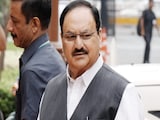India's first astronaut Rakesh Sharma on Monday said returning to Earth aboard the Soyuz spacecraft was the most thrilling experience of his space travel and for a moment he thought he would not make it back safely.
Mr Sharma shared his experiences as an astronaut at an event 'Youth Sabha 2047: Shaping India's Future,' organised by the Council on Energy, Environment and Water, and the United Nations Foundation.
In an interaction with Awais Ahmed, the co-founder and CEO of Pixxel Space, Mr Sharma said he was not worried about the launch phase of his space journey because everything was controlled by a computer.
"The reentry was more thrilling because I thought I wouldn't make it... That's when the parachute opens, and there's a lot of sound inside for which we were unprepared," he said, recounting the experience of the return journey.
Mr Sharma was selected for the Soviet Interkosmos mission in January 1982 and he flew aboard the Soyuz T-11 spacecraft from the Baikonur Cosmodrome on April 3, 1984. He spent seven days, 21 hours and 40 minutes in the space and returned to Earth on April 11.
"The metallic ring chafes against the hook of the spacecraft and because of its bell-shape, the sound gets amplified inside. I was convinced that the parachute would part company and the rest of the journey would be like a projectile — but that didn't happen," he said, recalling the re-entry of the Soyuz spacecraft into Earth's atmosphere.
On the launch of the spacecraft, he said the US Space Shuttle system allowed astronauts to look outside, while the Russians covered the entire rocket with a shroud leaving no chance for having visual inputs.
"You only have the tactile and the vibrations which are coming up 13 storeys from the engines and the G-forces keep increasing," Sharma said.
"So, the launch wasn't particularly worrisome because everything was computer-controlled. One was merely an interested bystander and an observer, wondering if the guys who had written the code had got it right," he said.
The former astronaut recommended the works of American astronomer and science communicator Carl Sagan for reading to the youngsters attending the event.
Sagan personified the "overview effect" — the cognitive shift astronauts experience when viewing Earth from space, Sharma said.
India is set to send its astronaut to space later this year as part of the joint mission with NASA and private space company Axiom.
IAF Wing Commander Shubhanshu Shukla is undergoing training in Houston for the Axiom Mission-4, the company's fourth commercial human spaceflight mission to the International Space Station.
India has also announced the Gaganyaan Mission to send astronauts to an orbit of 400 km sometime next year.
(Except for the headline, this story has not been edited by NDTV staff and is published from a syndicated feed.)















